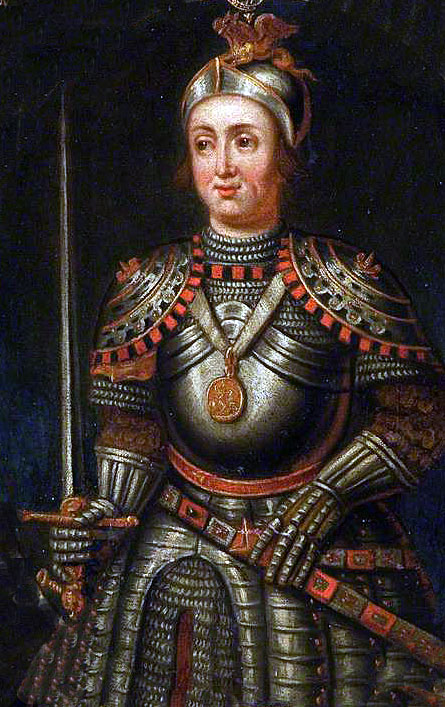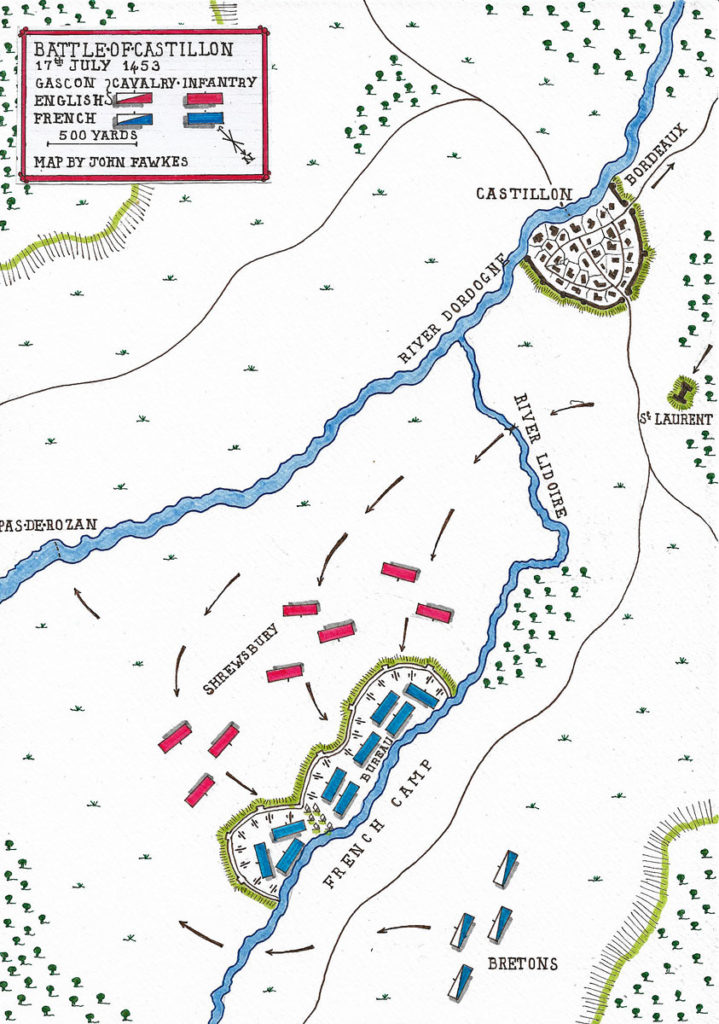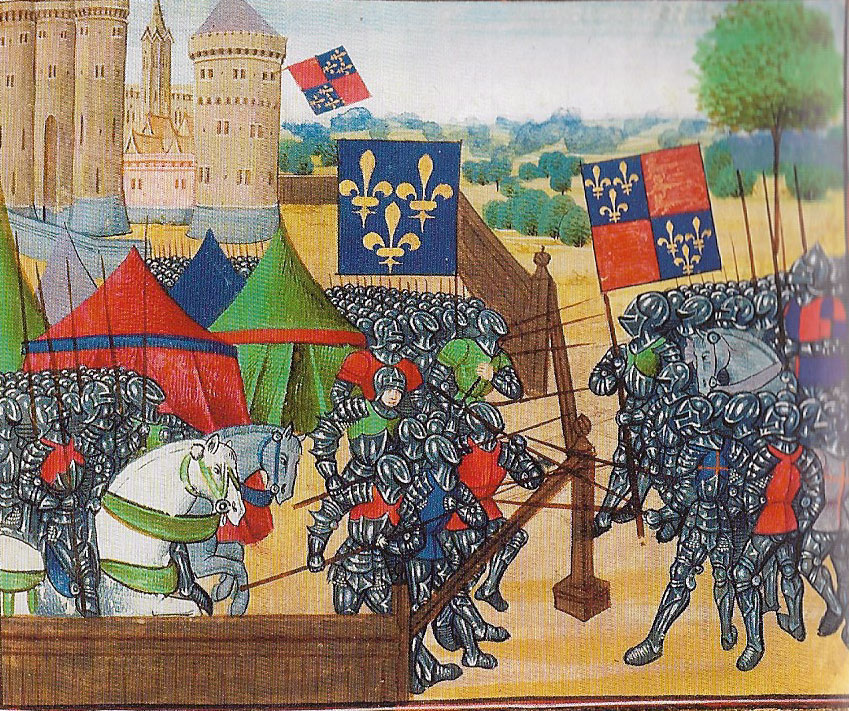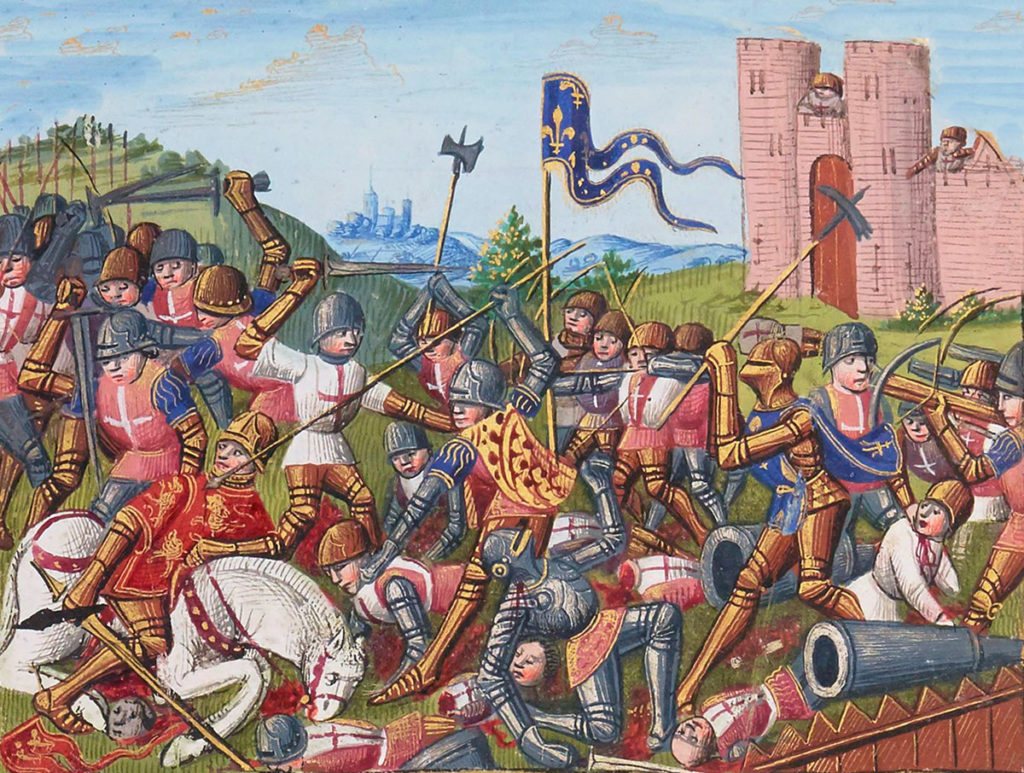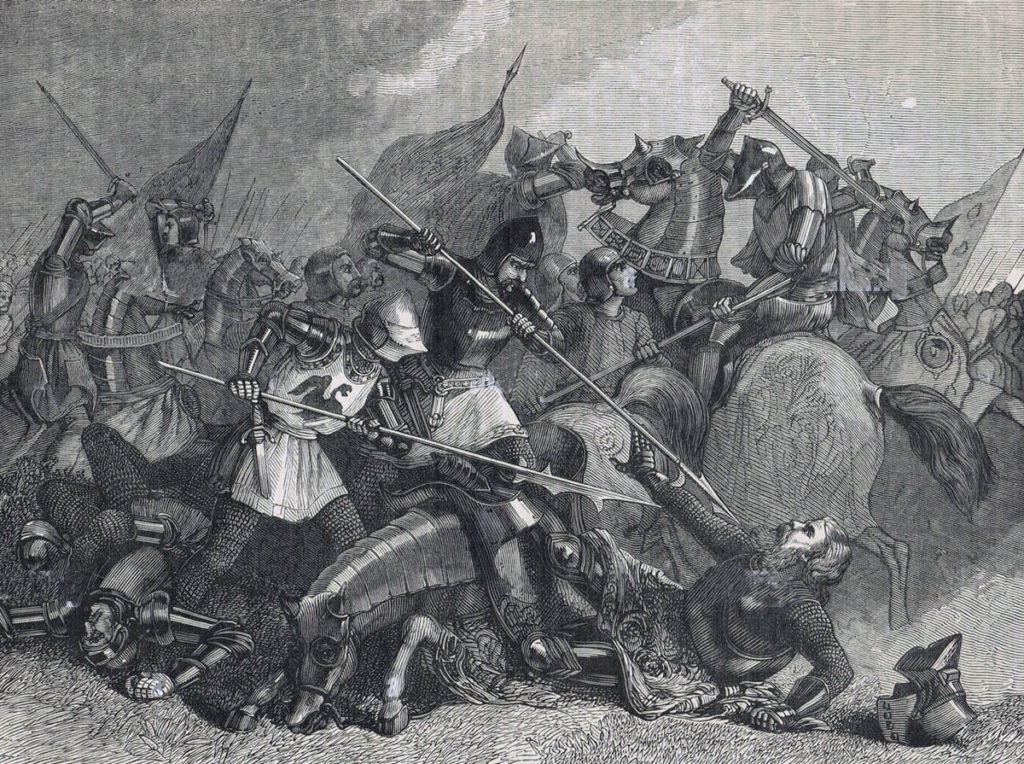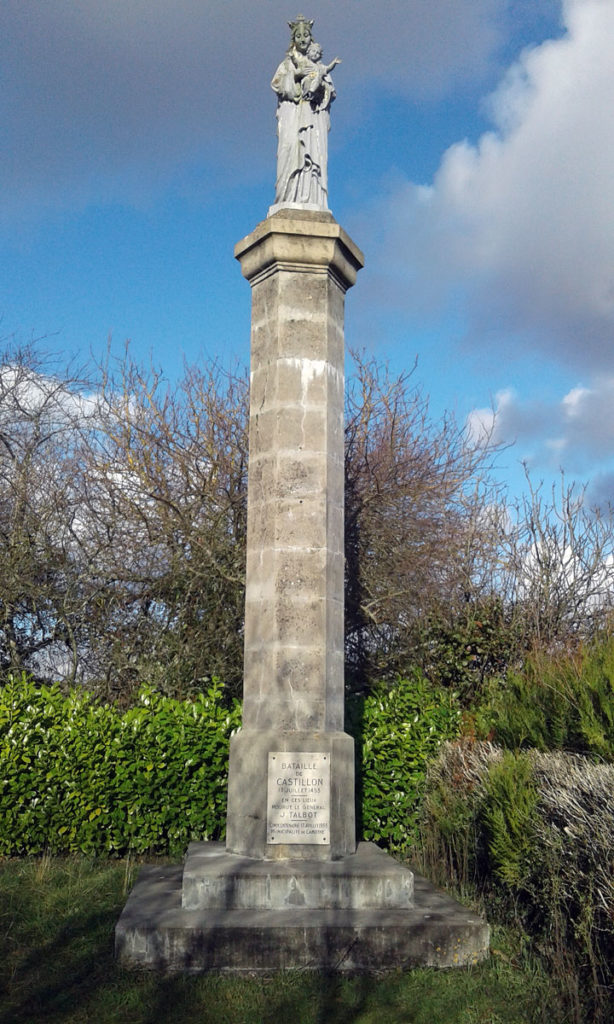The death of the English commander John Talbot, Earl of Shrewsbury and the defeat of his Anglo-Gascon army by the French artillery general Jean Bureau on 17th July 1453 in the battle that ended English dominion over Gascony and brought the Hundred Years War between England and France to a close
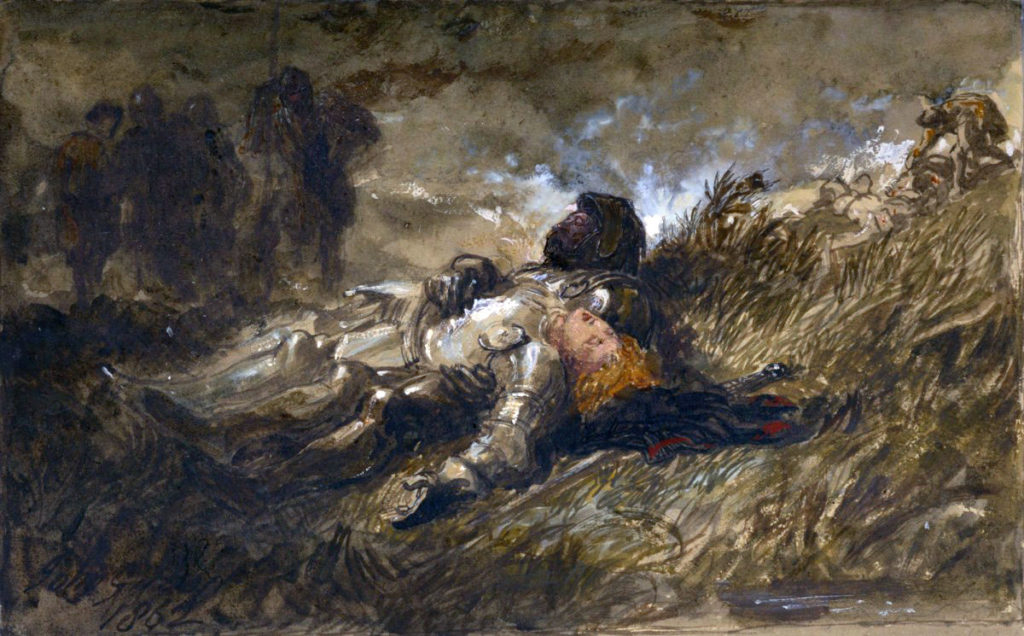
The previous battle of the Hundred Years War is the Battle of Formigny
The next battle in the British Battles series is the First Battle of St Albans
War: Hundred Years War.
Date of the Battle of Castillon:
17th July 1453
Place of the Battle of Castillon:
In France, on the River Dordogne, thirty miles east of the city of Bordeaux.
Combatants at the Battle of Castillon:
An Anglo-Gascon army against a French army.
Commanders at the Battle of Castillon:
John Talbot, Earl of Shrewsbury commanded the Anglo-Gascon army.
Jean Bureau commanded the French artillery and among the several French commanders exerted overall command over the French army.
Size of the armies at the Battle of Castillon:
The Anglo-Gascon army probably numbered around 3,000 men.
The French army numbered around 9,000 men.
The French deployed probably around 200 cannons while the Anglo-Gascon had none.
Uniforms, arms and equipment at the Battle of Castillon:
Knights increasingly wore steel plate armour with visored helmets. Their weapons were lance, shield, sword, various forms of mace or club and dagger. Many carried two-handed swords in battle. Each knight wore his coat of arms on his surcoat and shield.
The English archers carried a powerful bow, capable of many aimed shots a minute.
For hand-to-hand combat archers carried swords, daggers, hatchets and war hammers. They wore jackets and loose hose. Archers’ headgear was a skull cap either of boiled leather or wickerwork ribbed with a steel frame.
By the time of the Battle of Castillon, artillery was a well-established weapon of war frequently used in sieges and increasingly on the battlefield, as at Castillon.
Winner of the Battle of Castillon:
The French decisively defeated the English, killing John Talbot, Earl of Shrewsbury, the iconic English commander and dispersing his army.
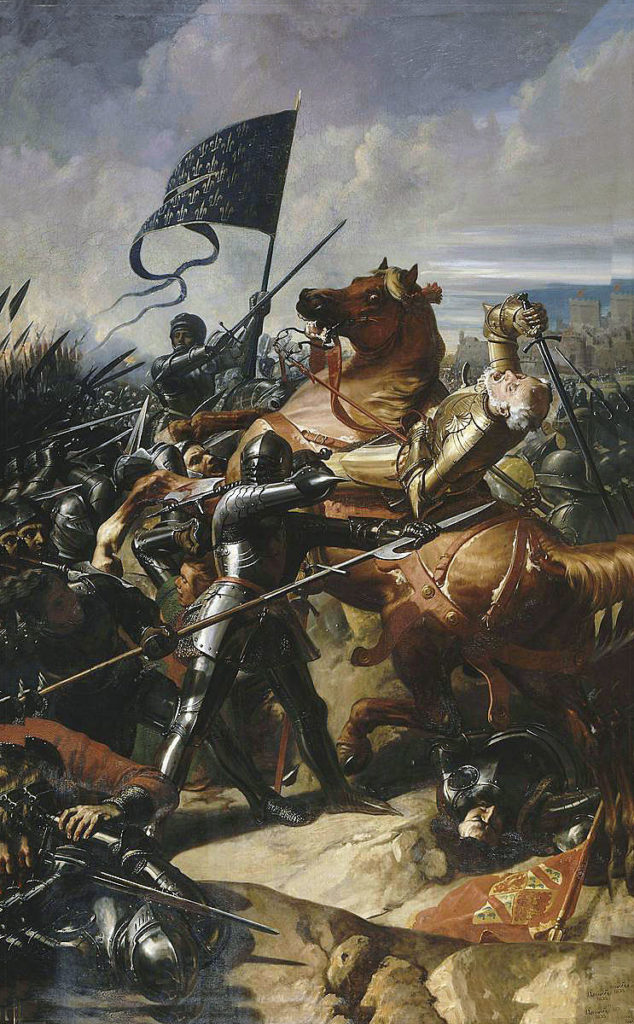
Events leading to the Battle of Castillon:
Following the French recapture of Normandy from the English, in 1451, King Charles VII of France turned his attention to Gascony, the largest area still held by the English, with their Gascon allies.
The Comte de Dunois marched into Gascony at the head of a large French army and on 30th June 1451 captured Bordeaux, the principal city of Gascony. It seemed that the 300-year-old rule by the King of England over Gascony had ended.
However, the King of France was under no illusions and conceded privately that the Gascons preferred to be ruled by the English than the French Crown.
In March 1452, the City of Bordeaux sent a deputation of its most senior citizens to England to request that the King of England send an army to expel the French from Gascony and resume his rule of the province.
King Henry VI of England raised an army and despatched it to Gascony, under John Talbot, the Earl of Shrewsbury, one of England’s most experienced soldiers, its task being to expel the French army from Gascony and recover the province for the King of England.
The English army, numbering around 3,000 men, arrived in Gascony on 17th October 1452.
The citizens of Bordeaux ejected the French garrison and admitted Talbot’s army, the city’s actions being followed by many of the other towns in western Gascony, other than a few that had to be taken by force.
In the spring of 1453, the King of France began to collect troops to re-conquer Gascony.
In midsummer 1453, three French armies began a concerted advance on Bordeaux, from the south-east, the east and the north-east.
Talbot’s Anglo-Gascon may have been as many as 6,000 men, but it was considerably outnumbered by the total of the French forces advancing into Gascony, in spite of a recent reinforcement from England commanded by Talbot’s son Lord de Lisle.
In mid-July 1453, the centre French army reached Castillon, a small walled town thirty miles east of Bordeaux and prepared to besiege the town.
The citizens of Castillon sent urgently to Bordeaux to be relieved.
Talbot’s plan was to permit the French armies to approach nearer to Bordeaux before attacking them.
However, Talbot was subjected to irresistible pressure from the Gascons to advance to the relief of Castillon and finally agreed to do so.
The French army outside Castillon was composed of contingents from several parts of France and seems to have lacked an overall commander.
The soldier with the greatest experience and authority was Jean Bureau, the French King’s artillery expert, who commanded a large contingent of cannon, possible in excess of 200 in number.
Bureau appears to have exercised overall command of the French army at Castillon.
In preparation for the siege and to face the threat of an Anglo-Gascon advance, Bureau caused his troops to build an extensive fortified camp along the bank of the River Lidoire to the east of Castillon.
Bureau positioned his large number of cannons along the perimeter of the camp to bring any assault under a heavy barrage.
Battle of Castillon:
On 16th July 1453, Talbot, with his son Lord de L’Isle, marched his army out of Bordeaux along the north bank of the River Dordogne towards Castillon.
Leaving before dawn, Talbot lead his mounted troops at a fast pace, the foot soldiers hurrying after them as best they could.
Reaching the town of Libourne in the evening, Talbot marched on through the night, inclining to the left to take a route through the forest.
The mounted troops with Talbot comprised some 500 men-at-arms and 800 archers.
Talbot halted for a few hours around midnight, before marching on through St Emilion and along the crest of the northern side of the Dordogne valley.
At around dawn on 17th July 1453, the English column began to emerge from the forest to the north-west of the Priory of Saint Lauren.
The Priory was held by a force of some 500 French archers.
The appearance of the English mounted men-at-arms and archers from the forest was entirely unexpected by the French.
The French maintained outposts on the main Bayeaux road from Castillon, which Shrewsbury, by his march through the woods, had evaded.
The English attacked the Priory and quickly overwhelmed the French archers, the survivors escaping across the River Lidoire to take refuge in the main French camp.
There was a limited pursuit by mounted English men-at-arms and archers, who returned with a full account of the layout of the French encampment.
After the exhausting march and the early morning capture of the Priory, Talbot had no intention of an immediate attack on the French camp and the English settled in the Priory to rest and eat.
While Talbot was breakfasting, a message arrived from the town, which was held by pro-English Gascons, in considerable excitement, with the news that the French were abandoning their camp and moving away eastwards.
Talbot immediately resolved to attack the French before they could get away.
Talbot was accompanied by only part of his army. The larger unmounted portion of his troops had been left far behind by the rapid advance of the mounted troops and had yet to come up.
Several of Talbot’s senior officer, including Sir Thomas Evringham, urged him to await the arrival of his foot soldiers before attacking the French camp.
Talbot, ever impetuous and hotheaded, rejected this advice and resolved to attack the French without delay and before they could escape.
The English force marched out of the Priory and, crossing the River Lidoire, advanced to the southern side of the camp, the side that faced the River Dordogne.
On arrival opposite the French camp, the Anglo-Gascons found it to be fully manned with no sign of any withdrawal.
The false report from the town would appear to have been based on the movement of led horses, leaving the camp to make room for the escaping French archers from the Priory.
In spite of his force being heavily outnumbered by the French troops in the camp and being faced by several hundred French cannon, with no cannon of his own yet come up, Talbot resolved on an immediate assault on the French camp.
Talbot ordered his men to dismount and attack the French camp.
The attack was nearly successful.
The Anglo-Gascons were gaining ground against the French in the camp when the reserve of Breton cavalry, held behind the camp, crossed the River Lidoire to the east of the camp and attacked the Anglo-Gascons in the flank with a mounted charge.
This unexpected attack into their right flank, when the outcome of the battle was still in doubt, was sufficient to overwhelm the Anglo-Gascon army.
The Anglo-Gascon army broke up into flight, the troops attempting to escape across the fast-flowing River Dordogne.
A ford was found at the Pas de Rozan and many Anglo-Gascon men-at-arms and archers were enabled to escape by that route.
At this point, Talbot’s horse was struck by an artillery round and Talbot was brought to the ground where he was killed.
Talbot’s son Lord de Lisle died with his father.
Casualties at the Battle of Castillon:
The level of casualties at the Battle of Castillon is far from clear. Either through death in battle or simply by dispersing, the Anglo-Gascon army ceased to exist and the English finally lost control of Gascony.
The surviving English soldiers either made their way back to England or became absorbed into the local population.
As the victors at Castillon, French casualties are likely to have been relatively light, perhaps a few hundred.
Follow-up to the Battle of Castillon:
With the destruction of the last Anglo-Gascon army at Castillon, Bordeaux was compelled to submit to the French King in October 1453 and Gascony ceased, after some 300 years, to be a dominion of the English Crown.
The Hundred Years War between England and France ended. There was however no formal peace treaty, the English kings have not formally abandoned their claim to the throne of France and the French ‘fleur-de-lys’ emblem remained in the English royal coat of arms until 1805.
Anecdotes and Traditions from the Battle of Castillon:
- Lord Talbot, Early of Shrewsbury, went into battle at Castillon wearing purple cap and civilian clothes and without armour. After his capture by the French in1450, Talbot swore to the French King that he would not wear armour against him again, an oath he maintained.
- After his horse was struck by the artillery round, Talbot was pinned beneath the dead animal. A Frenchman named Michel Perunin struck the earl on the head with a battle-axe and killed him.
- Talbot was initially buried on the battlefield. His body was later removed and interred at Falaise. At the end of the century a relative removed the body and reburied it at Whitchurch in Shropshire.
- The French referred to Talbot as ‘l’Achille Anglais’ (the English Achilles). The French erected a memorial to Talbot on the battlefield, known as ‘La Tombe de Talbot’. The memorial was apparently destroyed during the French Revolution, but replaced.
References for the Battle of Castillon:
The Art of War in the Middle Ages Volume Two by Sir Charles Oman..
The Hundred Years War by Burne
British Battles by Grant.
The previous battle of the Hundred Years War is the Battle of Formigny
The next battle in the British Battles series is the First Battle of St Albans
